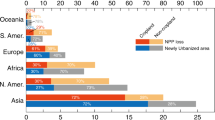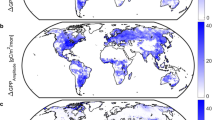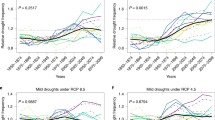Abstract
Ground- and aircraft-based measurements show that the seasonal amplitude of Northern Hemisphere atmospheric carbon dioxide (CO2) concentrations has increased by as much as 50 per cent over the past 50 years1,2,3. This increase has been linked to changes in temperate, boreal and arctic ecosystem properties and processes such as enhanced photosynthesis, increased heterotrophic respiration, and expansion of woody vegetation4,5,6. However, the precise causal mechanisms behind the observed changes in atmospheric CO2 seasonality remain unclear2,3,4. Here we use production statistics and a carbon accounting model to show that increases in agricultural productivity, which have been largely overlooked in previous investigations, explain as much as a quarter of the observed changes in atmospheric CO2 seasonality. Specifically, Northern Hemisphere extratropical maize, wheat, rice, and soybean production grew by 240 per cent between 1961 and 2008, thereby increasing the amount of net carbon uptake by croplands during the Northern Hemisphere growing season by 0.33 petagrams. Maize alone accounts for two-thirds of this change, owing mostly to agricultural intensification within concentrated production zones in the midwestern United States and northern China. Maize, wheat, rice, and soybeans account for about 68 per cent of extratropical dry biomass production, so it is likely that the total impact of increased agricultural production exceeds the amount quantified here.
This is a preview of subscription content, access via your institution
Access options
Subscribe to this journal
Receive 51 print issues and online access
$199.00 per year
only $3.90 per issue
Buy this article
- Purchase on Springer Link
- Instant access to full article PDF
Prices may be subject to local taxes which are calculated during checkout



Similar content being viewed by others
References
Keeling, C., Chin, J. & Whorf, T. Increased activity of northern vegetation inferred from atmospheric CO2 measurements. Nature 382, 146–149 (1996)
Randerson, J., Thompson, M., Conway, T., Fung, I. & Field, C. The contribution of terrestrial sources and sinks to trends in the seasonal cycle of atmospheric carbon dioxide. Glob. Biogeochem. Cycles 11, 535–560 (1997)
Graven, H. D. et al. Enhanced seasonal exchange of CO2 by northern ecosystems since 1960. Science 341, 1085–1089 (2013)
Piao, S. et al. Net carbon dioxide losses of northern ecosystems in response to autumn warming. Nature 451, 49–52 (2008)
Elmendorf, S. C. et al. Plot-scale evidence of tundra vegetation change and links to recent summer warming. Nature Clim. Change 2, 453–457 (2012)
Barichivich, J. et al. Large-scale variations in the vegetation growing season and annual cycle of atmospheric CO2 at high northern latitudes from 1950 to 2011. Glob. Change Biol. 19, 3167–3183 (2013)
Bacastow, R., Keeling, C. & Whorf, T. Seasonal amplitude increase in atmospheric CO2 concentration at Mauna Loa, Hawaii, 1959–1982. J. Geophys. Res. D 90, 10529–10540 (1985)
Pearman, G. & Hyson, P. The annual variation of atmospheric CO2 concentration observed in the Northern Hemisphere. J. Geophys. Res. Oceans 86, 9839–9843 (1981)
Xu, L. et al. Temperature and vegetation seasonality diminishment over northern lands. Nature Clim. Change 3, 581–586 (2013)
Falge, E. et al. Seasonality of ecosystem respiration and gross primary production as derived from FluxNET measurements. Agric. For. Meteorol. 113, 53–74 (2002)
FAO. FAOSTAT Databasehttp://faostat.fao.org/ (Food and Agriculture Organization of the United Nations, 2013)
Tilman, D., Balzer, C., Hill, J. & Befort, B. L. Global food demand and the sustainable intensification of agriculture. Proc. Natl Acad. Sci. USA 108, 20260–20264 (2011)
Ray, D. K., Ramankutty, N., Mueller, N. D., West, P. C. & Foley, J. A. Recent patterns of crop yield growth and stagnation. Nature Commun. 3, 1293 (2012)
Kucharik, C. J. Contribution of planting date trends to increased maize yields in the central United States. Agron. J. 100, 328–336 (2008)
Mueller, N. D. et al. Closing yield gaps through nutrient and water management. Nature 490, 254–257 (2012)
Vermeulen, S. J., Campbell, B. M. & Ingram, J. S. I. Climate change and food systems. Annu. Rev. Environ. Resour. 37, 195–222 (2012)
West, T. & Marland, G. Net carbon flux from agriculture: carbon emissions, carbon sequestration, crop yield, and land-use change. Biogeochemistry 63, 73–83 (2003)
West, T. & Marland, G. A synthesis of carbon sequestration, carbon emissions, and net carbon flux in agriculture: comparing tillage practices in the United States. Agric. Ecosyst. Environ. 91, 217–232 (2002)
Keppel-Aleks, G. et al. Atmospheric carbon dioxide variability in the community earth system model: evaluation and transient dynamics during the twentieth and twenty-first centuries. J. Clim. 26, 4447–4475 (2013)
Guanter, L. et al. Global and time-resolved monitoring of crop photosynthesis with chlorophyll fluorescence. Proc. Natl Acad. Sci. 111, E1327–E1333 (2014)
Nemani, R. R. et al. Climate-driven increases in global terrestrial net primary production from 1982 to 1999. Science 300, 1560–1563 (2003)
Chapin, F. et al. Role of land-surface changes in Arctic summer warming. Science 310, 657–660 (2005)
Goetz, S., Bunn, A., Fiske, G. & Houghton, R. Satellite-observed photosynthetic trends across boreal North America associated with climate and fire disturbance. Proc. Natl Acad. Sci. USA 102, 13521–13525 (2005)
McGuire, A. D. et al. Carbon balance of the terrestrial biosphere in the twentieth century: analyses of CO2, climate and land use effects with four process-based ecosystem models. Glob. Biogeochem. Cycles 15, 183–206 (2001)
Buermann, W. et al. The changing carbon cycle at Mauna Loa observatory. Proc. Natl Acad. Sci. USA 104, 4249–4254 (2007)
Angert, A. et al. Drier summers cancel out the CO2 uptake enhancement induced by warmer springs. Proc. Natl Acad. Sci. USA 102, 10823–10827 (2005)
Stephens, B. B. et al. Weak northern and strong tropical land carbon uptake from vertical profiles of atmospheric CO2 . Science 316, 1732–1735 (2007)
Pan, Y. et al. A large and persistent carbon sink in the world’s forests. Science 333, 988–993 (2011)
Le Quéré, C. et al. The global carbon budget 1959–2011. Earth Syst. Sci. Data Discuss. 5, 1107–1157 (2012)
Foley, J. A. et al. Solutions for a cultivated planet. Nature 478, 337–342 (2011)
West, T. O., Bandaru, V., Brandt, C. C., Schuh, A. E. & Ogle, S. M. Regional uptake and release of crop carbon in the United States. Biogeosciences 8, 2037–2046 (2011)
Prince, S., Haskett, J., Steininger, M., Strand, H. & Wright, R. Net primary production of US midwest croplands from agricultural harvest yield data. Ecol. Appl. 11, 1194–1205 (2001)
Lobell, D. et al. Satellite estimates of productivity and light use efficiency in united states agriculture, 1982-98. Glob. Change Biol. 8, 722–735 (2002)
Hay, R. Harvest index—a review of its use in plant-breeding and crop physiology. Ann. Appl. Biol. 126, 197–216 (1995)
Sinclair, T. Historical changes in harvest index and crop nitrogen accumulation. Crop Sci. 38, 638–643 (1998)
Kumudini, S., Hume, D. & Chu, G. Genetic improvement in short season soybeans: I. dry matter accumulation, partitioning, and leaf area duration. Crop Sci. 41, 391–398 (2001)
Wirsenius, S. Efficiencies and biomass appropriation of food commodities on global and regional levels. Agric. Syst. 77, 219–255 (2003)
Shearman, V., Sylvester-Bradley, R., Scott, R. & Foulkes, M. Physiological processes associated with wheat yield progress in the UK. Crop Sci. 45, 175–185 (2005)
Johnson, J. M. F., Allmaras, R. R. & Reicosky, D. C. Estimating source carbon from crop residues, roots and rhizodeposits using the national grain-yield database. Agron. J. 98, 622–636 (2006)
Haberl, H. et al. Quantifying and mapping the human appropriation of net primary production in earth’s terrestrial ecosystems. Proc. Natl Acad. Sci. USA 104, 12942–12947 (2007)
Lorenz, A. J., Gustafson, T. J., Coors, J. G. & de Leon, N. Breeding maize for a bioeconomy: a literature survey examining harvest index and stover yield and their relationship to grain yield. Crop Sci. 50, 1–12 (2010)
Ma, S.-C., Li, F.-M., Xu, B.-C. & Huang, Z.-B. Effect of lowering the root/shoot ratio by pruning roots on water use efficiency and grain yield of winter wheat. Field Crops Res. 115, 158–164 (2010)
Yang, J. & Zhang, J. Crop management techniques to enhance harvest index in rice. J. Exp. Bot. 61, 3177–3189 (2010)
Gower, S. T., Kucharik, C. J. & Norman, J. M. Direct and indirect estimation of leaf area index, fAPAR, and net primary production of terrestrial ecosystems. Remote Sens. Environ. 70, 29–51 (1999)
Bonifas, K., Walters, D., Cassman, K. & Lindquist, J. Nitrogen supply affects root: shoot ratio in corn and velvetleaf (Abutilon theophrasti). Weed Sci. 53, 670–675 (2005)
Insalud, N., Bell, R. W., Colmer, T. D. & Rerkasem, B. Morphological and physiological responses of rice (Oryza sativa) to limited phosphorus supply in aerated and stagnant solution culture. Ann. Bot. 98, 995–1004 (2006)
Jing, L., Shi-Qing, L., Yi, L. & Xiao-Li, C. Effects of increased ammonia on root/shoot ratio, grain yield and nitrogen use efficiency of two wheat varieties with various N supply. Plant Soil Environ. 55, 273–280 (2009)
Arai-Sanoh, Y., Ishimaru, T., Ohsumi, A. & Kondo, M. Effects of soil temperature on growth and root function in rice. Plant Prod. Sci. 13, 235–242 (2010)
Gehring, C. et al. Ecological intensification of rice production in the lowlands of Amazonia—options for smallholder rice producers. Eur. J. Agron. 46, 25–33 (2013)
Williams, J. D. et al. Root:shoot ratios and belowground biomass distribution for pacific northwest dryland crops. J. Soil Water Conserv. 68, 349–360 (2013)
FluxNET. http://www.fluxdata.org (2014)
Aubinet, M. et al. Carbon sequestration by a crop over a 4-year sugar beet/winter wheat/seed potato/winter wheat rotation cycle. Agric. For. Meteorol. 149, 407–418 (2009)
Dawe, D., Frolking, S. & Li, C. Trends in rice-wheat area in China. Field Crops Res. 87, 89–95 (2004)
Sacks, W. J., Deryng, D., Foley, J. A. & Ramankutty, N. Crop planting dates: an analysis of global patterns. Glob. Ecol. Biogeogr. 19, 607–620 (2010)
Schnyder, H. The role of carbohydrate storage and redistribution in the source-sink relations of wheat and barley during grain filling—a review. New Phytol. 123, 233–245 (1993)
Frolking, S. et al. Combining remote sensing and ground census data to develop new maps of the distribution of rice agriculture in China. Glob. Biogeochem. Cycles 16, 1091 (2002)
Qiu, J. et al. Mapping single-, double-, and triple-crop agriculture in China at 0.5x0.5 by combining county-scale census data with remote sensing-derived land cover map. Geocarto Int. 18, 3–13 (2003)
Baker, J. M., Ochsner, T. E., Venterea, R. T. & Griffis, T. J. Tillage and soil carbon sequestration—what do we really know? Agric. Ecosyst. Environ. 118, 1–5 (2007)
DeFries, R., Field, C., Fung, I., Collatz, G. & Bounoua, L. Combining satellite data and biogeochemical models to estimate global effects of human-induced land cover change on carbon emissions and primary productivity. Glob. Biogeochem. Cycles 13, 803–815 (1999)
Acknowledgements
This work used eddy covariance data acquired by the FLUXNET community and in particular by the following networks: AmeriFlux (US Department of Energy, Biological and Environmental Research, Terrestrial Carbon Program (DE-FG02-04ER63917 and DE-FG02-04ER63911)), AfriFlux, AsiaFlux, CarboAfrica, CarboEuropeIP, CarboItaly, CarboMont, ChinaFlux, Fluxnet-Canada (supported by CFCAS, NSERC, BIOCAP, Environment Canada, and NRCan), GreenGrass, KoFlux, LBA, NECC, OzFlux, TCOS-Siberia, USCCC. We acknowledge the financial support to the eddy covariance data harmonization provided by CarboEuropeIP, FAO-GTOS-TCO, iLEAPS, Max Planck Institute for Biogeochemistry, National Science Foundation, University of Tuscia, Université Laval and Environment Canada and US Department of Energy and the database development and technical support from Berkeley Water Center, Lawrence Berkeley National Laboratory, Microsoft Research eScience, Oak Ridge National Laboratory, University of California - Berkeley, University of Virginia. This work was supported by NASA grant number NNX11AE75G and NSF grant numbers EF-1064614 and NSF EAR-1038818. Research support to D.K.R. was primarily provided by the Gordon and Betty Moore Foundation and the Institute on Environment at the University of Minnesota. We also acknowledge input and data provided by H. Graven and P. Patra.
Author information
Authors and Affiliations
Contributions
J.M.G. led the design, analysis, and writing of the paper. J.M.G., S.F., N.R. and M.A.F. designed the analysis. E.A.K. provided the initial inspiration for the paper and guidance on interpreting atmospheric CO2 dynamics. C.J.K. contributed guidance on agronomic elements of the paper. D.K.R. provided the gridded MWRS data set. All authors edited and contributed to writing the paper.
Corresponding author
Ethics declarations
Competing interests
The authors declare no competing financial interests.
Additional information
MWRS yield and harvested area data will be archived at http://www.earthstat.org and are available on request.
Extended data figures and tables
Extended Data Figure 1 Calculating ΔS.
Schematic diagram showing the CO2 seasonality difference (ΔS) for two time periods representing a baseline condition (t1) with CO2 seasonality St1 and a scenario where NEE is enhanced 35% (t2) with correspondingly higher seasonality, St2. Flux-derived daily NEE (a), cumulative NEE (b), and NEPCUP and NEPCRP (c). Note the assumption that annual NEP = 0 (b).
Extended Data Figure 2 Harvest index and root:shoot ratio.
Crop-specific and MWRS aggregate distributions of literature-reported values of harvest index (a) and R:S (b).
Extended Data Figure 3 Agricultural fluxes from FluxNET.
NEE and GPP for agricultural FluxNET sites used in this study to determine the θ and φ parameters. Shading corresponds to May, June, July, and August, the CUP at the latitudes of most agricultural production, and the CUP definition used throughout this study.
Extended Data Figure 4 Parameter distributions.
PERT distributions for all Monte-Carlo-varied parameters in this study. Shown are moisture fraction (a), harvest efficiency (b), R:S ratio (c), harvest index (d), CUP proportion of NPP (e), and CUP proportion of Rh (f).
Extended Data Figure 5 Aggregation zones.
Eco-climatic (top; from ref. 3) and aggregated production regions (bottom) used in this study.
Extended Data Figure 6 Increased production and seasonality.
Change in MWRS production (top) and SCO2,MWRS (bottom) over the period 1965–2005.
Extended Data Figure 7 Remotely sensed growing season length.
Mean ‘greenup’ and dormancy values from MODIS Land Cover Dynamics product (MCD12Q2) for pixels identified as agriculture (AG) and deciduous broadleaf forest (DBF) in the MODIS Land Cover product (MCD12Q1; classes 12 and 4, respectively) for 1° latitudinal bands in North America (a) (MODIS tiles are h11v03, h12v03, h13v03, h10v04, h11v04, h12v04, h09v05, h10v05, and h11v05), and for China (b) (MODIS tiles are h23v03, h24v03, h25v03, h26v04, h27v04, h26v05, and h27v05.)
Rights and permissions
About this article
Cite this article
Gray, J., Frolking, S., Kort, E. et al. Direct human influence on atmospheric CO2 seasonality from increased cropland productivity. Nature 515, 398–401 (2014). https://doi.org/10.1038/nature13957
Received:
Accepted:
Published:
Issue Date:
DOI: https://doi.org/10.1038/nature13957
This article is cited by
-
Greening of human-dominated ecosystems in India
Communications Earth & Environment (2023)
-
Effects of elevated CO2 on resistant and susceptible rice cultivar and its primary host, brown planthopper (BPH), Nilaparvata lugens (Stål)
Scientific Reports (2021)
-
Warming temperatures lead to reduced summer carbon sequestration in the U.S. Corn Belt
Communications Earth & Environment (2021)
-
Comparisons of OCO-2 satellite derived XCO2 with in situ and modeled data over global ocean
Acta Oceanologica Sinica (2021)
-
Harmonized global maps of above and belowground biomass carbon density in the year 2010
Scientific Data (2020)
Comments
By submitting a comment you agree to abide by our Terms and Community Guidelines. If you find something abusive or that does not comply with our terms or guidelines please flag it as inappropriate.



